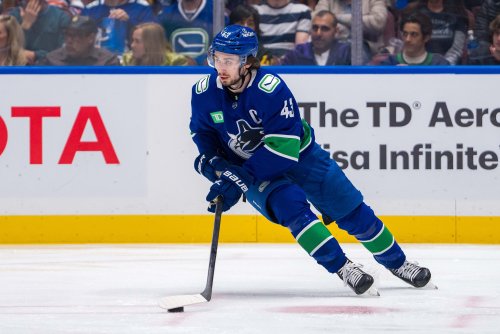
Friend of the blog, Bob Spencer, has already tackled this subject recently in depth, so make sure you read his take too.
What I'm gonna look at here is how Brodziak's performance compares to other forwards who have played an extremely defensive role this year. I want to find out if he has been one of the better "shutdown" forwards in the league, or at least doing a good enough job to excuse his lack of production.
The 19 forwards I will be analysing here have (A) played at least 50% of the season thus far, (B) have started at least 40% of their shifts in the defensive zone and © have accounted for at least 20% of their team's total even-strength TOI.
Firstly, let's see how much these forwards see the ice at even-strength to get an idea of how important they are to their team outside of just their "defensive specialist" role. "EVTm%" refers to the percentage of a team's even-strength ice time a player is on the ice for.
Usually the best defensive forwards also play a major role in penalty kill situations. Here are the players ranked by what percentage of their team's overall shorthanded minutes they were on the ice for:
Here are the players ranked by the percentage of shifts they have started in the defensive zone, a key trait of a defensive forward. I have also listed their offensive and neutral zone start percentages just to make sure that there aren't any players who are balancing a heavy defensive load with a lot of offensive zone starts:
Aside from zone-starts, the other important factor to consider when evaluating defensive forwards is the quality of competition they face. One way of doing this is by using TotTm% QoC, which measures the percentage of 5v5 ice time a player's on-ice opponents account for. More simply, it tells you whether or not a player is going up against the other team's best players (who account for a higher percentage of TOI) or the lesser players (who account of a lower percentage):
To get an even better idea of what Brodziak usually faces when he takes the ice, here are his most regular 5v5 opponents so far this year:
Now, let's look at how effective each player is at tilting the ice in favour of their team. This is where all the context provided by zone-starts, competition faced and the effect of teammates needs to be applied when looking at each player's numbers. You expect a defensive forward who starts more shifts in their own zone and against the other team's best players to end-up with a negative Corsi number, but the really effective ones should be able to keep it from being too ugly:
Here are the forwards ranked by their Even-Strength points production (EV P/60):
To get a better idea of how good or bad Brodziak's possession and production numbers are, I've narrowed this list down to the guys with at least 44.40% D-Zone starts, under 25% O-Zone starts and a TotTm% QoC of at least 28%:
Using the same group of similar players, let's take a deeper look at Brodziak's production issues this season. Below I have listed the players along with their Even Strength Points per 60 minutes (EV P/60), their individual shot-attempts per 60 minutes (EV CF/60), their goals and shooting percentage in all situations this season, their career shooting percentage before this season, their even-strength assists this season and their On-ice Sh%:
So, in conclusion:
Follow me on Twitter for more hockey-ness.
Think you could write a story like this? Hockey Wilderness wants you to develop your voice, find an audience, and we'll pay you to do it. Just fill out this form.







Recommended Comments
There are no comments to display.
Join the conversation
You can post now and register later. If you have an account, sign in now to post with your account.
Note: Your post will require moderator approval before it will be visible.